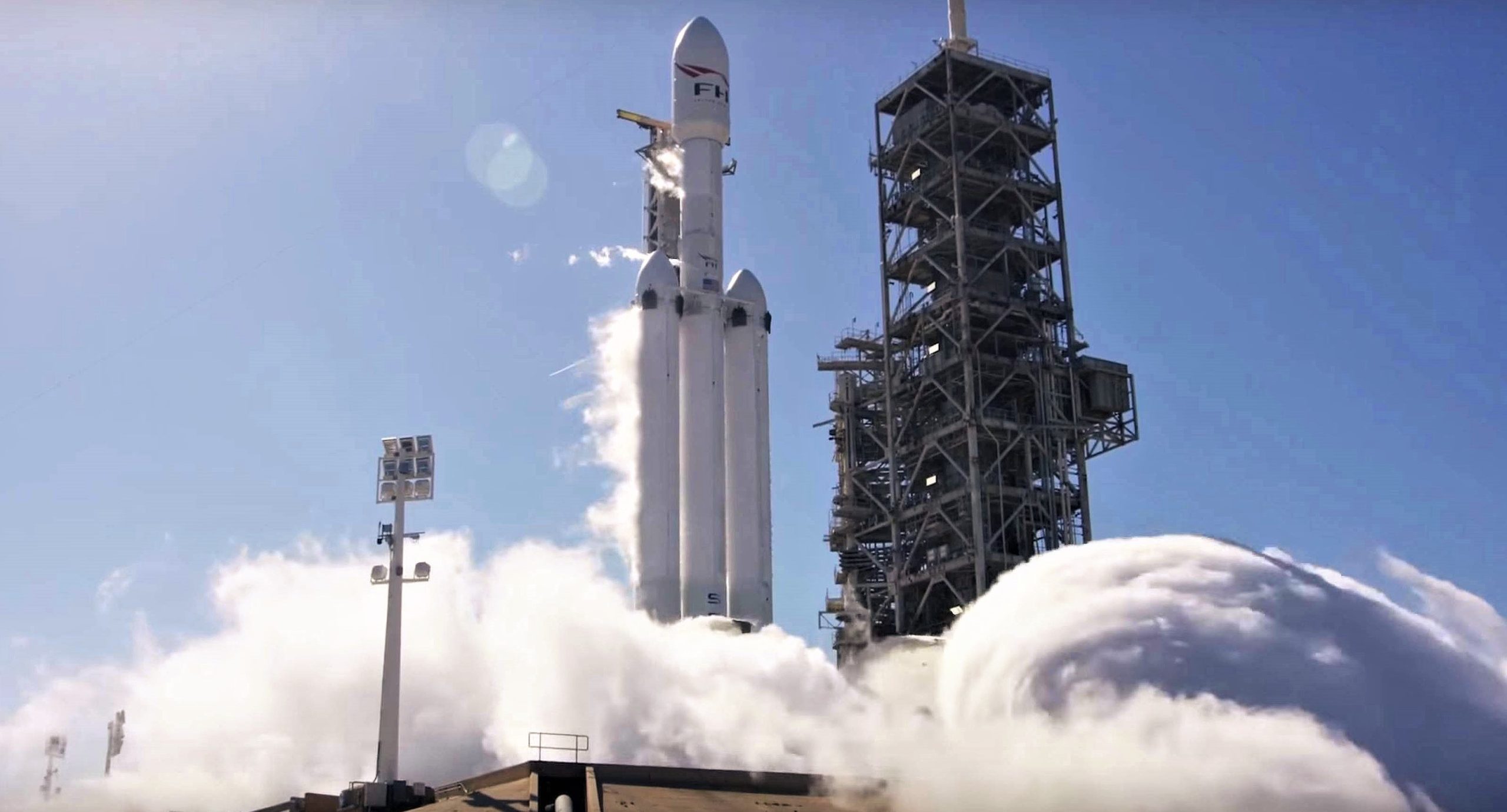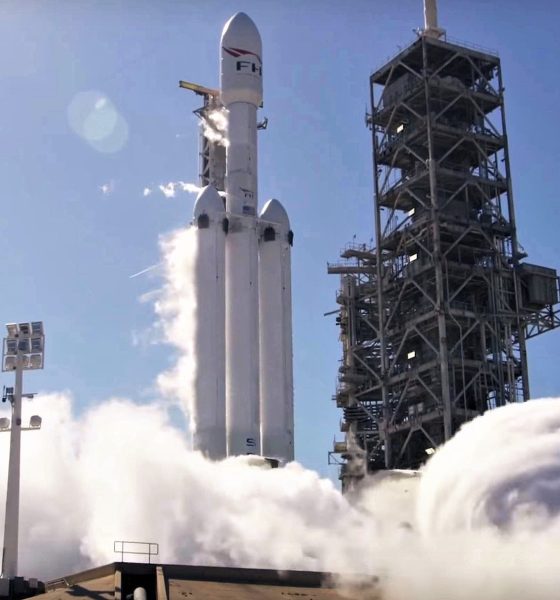

SpaceX
SpaceX’s Falcon Heavy to ignite all 27 Merlin engines in early morning test
SpaceX is set to take another stab at the first integrated static fire test of Falcon Heavy Block 5 rocket, a milestone that will open the doors for its commercial launch debut just a handful of days later.
The window for the second Falcon Heavy’s static fire test will open at
If all goes well during these relatively routine procedures, SpaceX can be expected to announce a date for Falcon Heavy’s second-ever launch, likely no sooner than 4-5 days after the static fire is completed. In other words, a flawless performance tomorrow could permit a launch date as early as April 9-10. Launching fewer than four days after completing static fire testing is rare even for Falcon 9, which has the luxury of far less complexity (and data produced) relative to Falcon Heavy, which has only flown once and
Three months after Falcon Heavy’s February 2018 debut, SpaceX debuted Falcon 9 in its upgraded Block 5 configuration, featuring widespread changes to avionics, software, structures, thermal protection, and even uprated thrust for its Merlin engines. Falcon Heavy Flight 1 was comprised of Block 2 and Block 3 variants of the Falcon 9’s umbrella V1.2 Full Thrust configuration, which debuted in December 2015. Both side boosters – Block 2s – were flight-proven and had previously launched in 2016, while the rocket’s heavily modified center core was effectively a new version of Falcon 9 based on Block 3 hardware.


One of the biggest goals of Block 5 / Version 6 is ease of reusability. In
And we have
Block 5 has improved payload to orbit. Improved redundancy. Improved reliability. It’s really better in every way than Block 4. I’m really proud of the SpaceX team for the design.
– SpaceX CEO Elon Musk, May 2018
A different different rocket
Given just how extensive the changes made with Block 5 are, Falcon Heavy Flight 2 is drastically different than its sole predecessor, emphasized by the 13+ months SpaceX has taken to go from Flight 1 to Flight 2. Had SpaceX been able to successfully recover Falcon Heavy’s first center core (B1033) after launch, its quite likely that the company would have attempted to refly the rocket’s three landed boosters a bit sooner than April 2019, but the booster’s failed landing threw a bit of a wrench in the production plan.
After intentionally expending almost a dozen recoverable Block 3 and 4 Falcon 9 boosters in 2017 and 2018, SpaceX’s fleet of flightworthy cores had been reduced to a tiny handful. Interrupting Falcon 9 Block 5’s production ramp would have likely become a bottleneck for 2018’s launch cadence, and may well have contributed to SpaceX falling short from its planned 30 and then 24 launches last year with a still-impressive 21. Building an entirely new Falcon Heavy center core was simply not a priority as SpaceX required all production hands on deck to build enough Block 5 boosters to avoid major launch delays.

As a result, SpaceX delayed the production of the first Falcon Heavy Block 5 center core by ~6 months and ~8 boosters, shipping the rocket – presumed to be B1055 – to McGregor, Texas for static fire acceptance testing in Q4 2018. The center core arrived in Florida in mid-February 2019, following both side cores and a payload fairing.
Ultimately, SpaceX is likely to conduct Falcon Heavy’s first commercial launch with about as much caution as could be observed during the unique launches of SSO-A (the first triple-
Stay tuned for an official SpaceX confirmation of Falcon Heavy’s second integrated static fire, as well as new launch date.
Check out Teslarati’s Marketplace! We offer Tesla accessories, including for the Tesla Cybertruck and Tesla Model 3.

News
SpaceX shades airline for seeking contract with Amazon’s Starlink rival

SpaceX employees, including its CEO Elon Musk, shaded American Airlines on social media this past weekend due to the company’s reported talks with Amazon’s Starlink rival, Leo.
Starlink has been adopted by several airlines, including United Airlines, Qatar Airways, Hawaiian Airlines, WestJet, Air France, airBaltic, and others. It has gained notoriety as an extremely solid, dependable, and reliable option for airline travel, as traditional options frequently cause users to lose connection to the internet.
Many airlines have made the switch, while others continue to mull the options available to them. American Airlines is one of them.
A report from Bloomberg indicates the airline is thinking of going with a Starlink rival owned by Amazon, called Leo. It was previously referred to as Project Kuiper.
American CEO Robert Isom said (via Bloomberg):
“While there’s Starlink, there are other low-Earth-orbit satellite opportunities that we can look at. We’re making sure that American is going to have what our customers need.”
Isom also said American has been in touch with Amazon about installing Leo on its aircraft, but he would not reveal the status of any discussions with the company.
The report caught the attention of Michael Nicolls, the Vice President of Starlink Engineering at SpaceX, who said:
“Only fly on airlines with good connectivity… and only one source of good connectivity at the moment…”
CEO Elon Musk replied to Nicolls by stating that American Airlines risks losing “a lot of customers if their connectivity solution fails.”
American Airlines will lose a lot of customers if their connectivity solution fails
— Elon Musk (@elonmusk) December 14, 2025
There are over 8,000 Starlink satellites in orbit currently, offering internet coverage in over 150 countries and territories globally. SpaceX expands its array of satellites nearly every week with launches from California and Florida, aiming to offer internet access to everyone across the globe.
Currently, the company is focusing on expanding into new markets, such as Africa and Asia.
News
Tesla hints at Starlink integration with recent patent
“By employing polymer blends, some examples enable RF transmission from all the modules to satellites and other communication devices both inside and outside the vehicle.”

Tesla hinted at a potential Starlink internet terminal integration within its vehicles in a recent patent, which describes a vehicle roof assembly with integrated radio frequency (RF) transparency.
The patent, which is Pub. No U.S. 2025/0368267 describes a new vehicle roof that is made of RF-transparent polymer materials, allowing and “facilitating clear communication with external devices and satellites.”
Tesla believes that a new vehicle roof design, comprised of different materials than the standard metallic or glass elements used in cars today, would allow the company to integrate modern vehicular technologies, “particularly those requiring radio frequency transmission and reception.
Tesla has recently filed a US patent application on integrating RF transparent materials into the roof structure.
“facilitating clear communication with external devices and satellites”
Tesla fleet is getting @Starlink connectivity integration soon. LFG @Tesla @elonmusk… pic.twitter.com/bLa8YtPLd1
— Chansoo Byeon (@Chansoo) December 9, 2025
Instead of glass or metallic materials, Tesla says vehicles may benefit from high-strength polymer blends, such as Polycarbonate, Acrylonitrile Butadiene Styrene, or Acrylonitrile Styrene Acrylate.
These materials still provide ideal strength metrics for crashworthiness, stiffness for noise, vibration, and harshness control, and are compliant with head impact regulations.
They would also enable better performance with modern technologies, like internet terminals, which need an uninterrupted signal to satellites for maximum reception. Tesla writes in the patent:
“By employing polymer blends, some examples enable RF transmission from all the modules to satellites and other communication devices both inside and outside the vehicle.”

One of the challenges Tesla seems to be aware of with this type of roof design is the fact that it will still have to enable safety and keep that at the forefront of the design. As you can see in the illustration above, Tesla plans to use four layers to increase safety and rigidity, while also combating noise and vibration.
It notes in the patent that disclosed examples still meet the safety requirements outlined in the Federal Motor Vehicle Safety Standards (FMVSS).
Starlink integrated directly into Tesla vehicles would be a considerable advantage for owners. It would come with a handful of distinct advantages.
Initially, the inclusion of Starlink would completely eliminate cellular dead zones, something that is an issue, especially in rural areas. Starlink would provide connectivity in these remote regions and would ensure uninterrupted service during road trips and off-grid adventures.
It could also be a critical addition for Robotaxi, as it is crucial to have solid and reliable connectivity for remote monitoring and fleet management.
Starlink’s growing constellation, thanks to SpaceX’s routine and frequent launch schedule, will provide secure, stable, and reliable internet connectivity for Tesla vehicles.
Although many owners have already mounted Starlink Mini dishes under their glass roofs for a similar experience, it may be integrated directly into Teslas in the coming years, either as an upgrade or a standard feature.
Investor's Corner
SpaceX IPO is coming, CEO Elon Musk confirms
However, it appears Musk is ready for SpaceX to go public, as Ars Technica Senior Space Editor Eric Berger wrote an op-ed that indicated he thought SpaceX would go public soon. Musk replied, basically confirming it.

Elon Musk confirmed through a post on X that a SpaceX initial public offering (IPO) is on the way after hinting at it several times earlier this year.
It also comes one day after Bloomberg reported that SpaceX was aiming for a valuation of $1.5 trillion, adding that it wanted to raise $30 billion.
Musk has been transparent for most of the year that he wanted to try to figure out a way to get Tesla shareholders to invest in SpaceX, giving them access to the stock.
He has also recognized the issues of having a public stock, like litigation exposure, quarterly reporting pressures, and other inconveniences.
However, it appears Musk is ready for SpaceX to go public, as Ars Technica Senior Space Editor Eric Berger wrote an op-ed that indicated he thought SpaceX would go public soon.
Musk replied, basically confirming it:
As usual, Eric is accurate
— Elon Musk (@elonmusk) December 10, 2025
Berger believes the IPO would help support the need for $30 billion or more in capital needed to fund AI integration projects, such as space-based data centers and lunar satellite factories. Musk confirmed recently that SpaceX “will be doing” data centers in orbit.
AI appears to be a “key part” of SpaceX getting to Musk, Berger also wrote. When writing about whether or not Optimus is a viable project and product for the company, he says that none of that matters. Musk thinks it is, and that’s all that matters.
It seems like Musk has certainly mulled something this big for a very long time, and the idea of taking SpaceX public is not just likely; it is necessary for the company to get to Mars.
The details of when SpaceX will finally hit that public status are not known. Many of the reports that came out over the past few days indicate it would happen in 2026, so sooner rather than later.
But there are a lot of things on Musk’s plate early next year, especially with Cybercab production, the potential launch of Unsupervised Full Self-Driving, and the Roadster unveiling, all planned for Q1.








